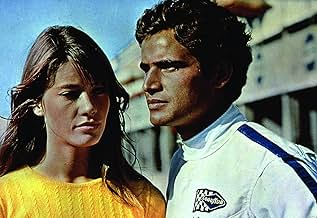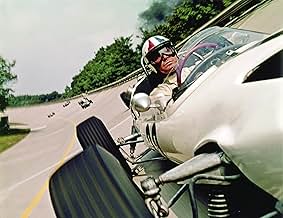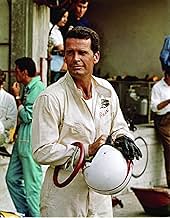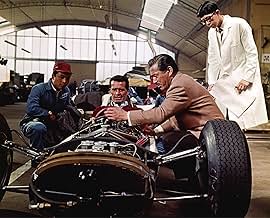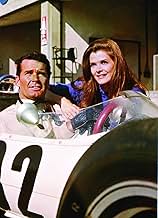Grand Prix
- 1966
- Tous publics
- 2h 56m
American Grand Prix driver Pete Aron is fired by his Jordan-BRM racing team after a crash at Monaco that injures his British teammate, Scott Stoddard.American Grand Prix driver Pete Aron is fired by his Jordan-BRM racing team after a crash at Monaco that injures his British teammate, Scott Stoddard.American Grand Prix driver Pete Aron is fired by his Jordan-BRM racing team after a crash at Monaco that injures his British teammate, Scott Stoddard.
- Won 3 Oscars
- 3 wins & 4 nominations total
- Izo Yamura
- (as Toshiro Mifune)
- Nino Barlini
- (as Antonio Sabàto)
- Monique Delvaux-Sarti
- (as Genevieve Page)
- Wallace Bennett
- (as Donal O'Brien)
- Surgeon
- (as Albert Remy)
Featured reviews
Well, Frankenheimer did all that back in the 60s and for that reason alone the movie is required watching for anyone who has even a slight interest in cars or motor sports. GP offers us a pretty realistic glimpse of an era gone-by - and it doesn't shy away from the gruesome reality and dangers of motor-racing in the 60s. This realism alone makes GP stand out. The filmmakers didn't simulate races, they actually had the actors racing cars on the original tracks and filmed it. The result is astonishing and really gives a feeling of what it must've been like to sit in one of those beautiful deathtraps at speeds of around 300 km/h. The excellent cinematography, editing and music add to this unique experience and they also give the picture that typical 60s-feel (the opening credits alone are worth the price of admission in my book).
On a side note: Being a racing-fan myself, I can't help but wonder why Frankenheimer didn't include the race at the Nürburgring. Back in those days, F1 still used the 20km+ Nordschleife-version of the track, possibly the most demanding and "scary" circuit ever.
Naturally: Between races the movie loses momentum. That's not so much caused by some weak dialog or the predictable plot - it's s just that those incredible scenes on the tracks simply steal the show. No wonder that I find myself fast-forwarding through a lot of the dialog.
In short: 10/10 for the action on the racetracks - 6/10 for the scenes off the track = 8/10
I don't recommend pairing this in a screening with _Days of Thunder_ for two reasons: First, GP is LONG; second, DoT will pale by comparison.
BTW, if you can rent it in DVD, get it that way and watch it on as big a TV as you can find. The soundtrack is incredible and the widescreen work is like nothing you'll ever see anywhere else.
If you get the chance to see this in a theater, DO NOT BE LATE!! The opening -- with the driver plugging his ears with cotton before putting on his helmet -- is aptly appropriate. The split-screen and multiple-image effects are first seen in the opening and crop up throughout the movie -- and always to good advantage, not just a "gee whiz, look what we can do" use of technique and technology. ESPN and the other networks, in their NASCAR telecasts, have just now started to adopt techniques first used by Frankenheimer 30-plus years ago.
One of the best scenes in the film is in the early minutes. You are actually *in* the cockpit of a F-1 car as it spins out of control, slides off the track, and launches itself into the harbor. I might add that this was *NOT* done with models, but used real, full-sized cars and took long hours to produce -- and these were truly "state-of-the-art" effects in 1966 (I won't give away the secrets here but will say that if you can locate a copy of the appropriate issue of "Popular Mechanics" [March 1966?] you will enjoy the article about the film and the techniques). The end result was about 15 seconds of some of the best racing footage committed to film. Needless to say, this is a very quick-running sequence!
I saw this picture in Cinerama in 1966, and I too echo the sentiment for a re-release of this picture to the large screen. More is the pity that Cinerama is no more. There are few pictures where Cinerama could be used to its fullest advantage; the in-car and on-track sequences of this film, however, were some of those.
"Titanic" wasn't about that pathetic love triangle story. It was a vehicle to get you into the night the great ship was lost. Grand Prix uses a relatively lame storyline about the private lives of the drivers to get you into their circle. I think it's all just a part of putting the audience into the car.
And I DO mean the car. Not a green screen half car and a CGI effect. A car. Several cars. At high speed, with cameras mounted and actors trained to actually drive them. No phony backgrounds projected. Watch NASCAR or INDY coverage on the SPEED Channel any weekend and you will see on-board shots from vidcams in real time. We're used to that now. Prior to "Grand Prix", there was NO such thing. Grand Prix stands with "Bullitt" and "The French Connection" as the greatest "cut to the chase" movies of all time.
Nothing is done like this any more. If you want to see the masters at work, rent these movies. This is pure analog fun at it's best, and it just doesn't get better with the switch to digits, because the thrill leaves along with the risk factor.
So tolerate the maudlin romantic claptrap. Laugh as you watch some of the stars of Formula 1 racing standing around grimacing into the camera at the infidelities of the British driver's wife (it is a riot), but stand and applaud in awe at the astounding achievement of John Frankenheimer and company at shooting a fictional Grand Prix season against the background of an actual Grand Prix season. It is awesome and worthy of your viewing time, even though the basic story falls short of Oscar caliber scripting.
Did you know
- TriviaOf the 32 professional racing drivers who participated or were seen in the film, five died in racing accidents within two years and another five in the following ten years.
- GoofsPrior to the start of the race at Monza, there is a flag ceremony at the starting line. The US flag has 48 stars instead of the 50 it should have had in 1966.
- Quotes
Jean-Pierre Sarti: The danger? Well, of course. But you are missing a very important point. I think if any of us imagined - really imagined - what it would be like to go into a tree at 150 miles per hour we would probably never get into the cars at all, none of us. So it has always seemed to me that to do something very dangerous requires a certain absence of imagination.
- ConnectionsEdited into Bass on Titles (1982)
- How long is Grand Prix?Powered by Alexa
Details
Box office
- Budget
- $9,000,000 (estimated)
- Runtime2 hours 56 minutes
- Color
- Aspect ratio
- 2.20 : 1
Contribute to this page




